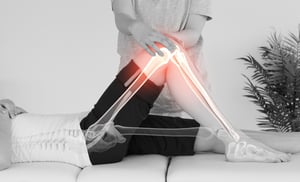What to Expect - And Helpful Advice

Guest Blogger:
Richard F. Seiden, Esq.
In this article, the AAOS Registry Program’s Public Advisory Board (PAB) member Richard Seiden shares his personal experience as a joint replacement surgery patient (he’s had hip replacements, knee replacements, and shoulder replacements). Mr. Seiden offers patients with joint issues helpful advice to better prepare for dealing with pre-, day-of-, and post-surgical needs. This article is not a substitute for physician recommendations.
I’d like to start by saying that I am not a medical professional and this article summarizes my own experiences and personal perspectives, so before you apply any of my advice to your own situation, consult your physician. However, if you have joint issues and are considering surgery, the sooner you start doing your homework and preparing, physically and emotionally, the better. Managing your weight and maintaining your muscle tone are two excellent starting points.
Do your best to lose weight prior to the surgery, or to maintain the lowest weight you can, so that you minimize stress on your joints, especially weight-bearing hips and knees. This will help during the surgery and recovery.
To further reduce stress on the joints, maintain the muscle tone of the muscles immediately surrounding the joints (quadriceps for the knees and hip flexors for the hips). Isometric exercises that focus on the specific joint(s) are particularly helpful. Prior to surgery, it’s worth the effort to learn some of these simple techniques from a physical therapist (PT) or by searching online at websites such as www.orthoinfo.org.
Not surprisingly, muscles are stronger and better able to handle weight bearing than the nearby joints. The more you allow those muscles to atrophy, the more pressure you put on the joints, and the more likely you will do more extensive damage to the joints. Also, if you do not maintain muscle tone, you will have to spend more time during recovery rebuilding these muscles.
Unfortunately, I did not learn this lesson until I spoke to a PT after my first surgery, bilateral knee replacements. It took me about 10 days to restore strength to my quadriceps, which are the muscles that enable you to stand up, sit down, climb stairs, and do other vital activities.
Considerations Prior to Surgery
Selecting your orthopedic surgeon is probably the most critical decision you will make. Seek out recommendations from your rheumatologist or other physicians, and review the online biographies and comments about the recommended surgeon(s).
Factors to consider when choosing your surgeon include:
- Surgeon experience and patient-friendliness. Do your best to determine whether the surgeon is patient-friendly, willing to answer all of your questions, and has experience with your particular joint. It is reasonable to ask how many procedures of the type you are considering he or she has performed.
- Office organization and communication. You'll also want to find out if the surgeon's office makes and keeps appointments in a timely manner. Ideally, the office should call you when delays are expected and offer you a choice about when to arrive. Having to wait in a surgeon's waiting room for more than 30 minutes is unacceptable. In addition to promoting patient and caregiver anxiety, a poorly organized practice to some extent reflects his/her attitude toward patients.
Note whether the surgeon apologizes for any delay in the waiting room. Also listen to the comments made by patients in the waiting room. Although they may or may not be reliable, hearing a lot of complaints is not an endorsement. You should also confirm that it's easy to communicate via phone or online with the surgeon's office after the surgery.
Pay close attention to any communications that the surgeon sends you. You may be asked to complete a survey based on your pain level and/or emotional state. These surveys are an important part of your treatment plan and help to utilize data to be able to improve joint procedures for future patients. - Imaging capability. The surgeon should order appropriate imaging and provide a diagnosis and course of treatment based on the results. For example, many offices do not require x-rays. Although x-rays may miss some of the more obvious arthritis problems otherwise confirmed on MRIs, they really are necessary in some cases. Sometimes, it may turn out that surgery is not necessary in the near future, and the use of an assistive device or a prescribed medication may work instead.
- Ability to manage expectations. The surgeon should provide hard copies of materials regarding pre-operative protocols, and what to expect before, during, and after the surgery. Ongoing information, recommendations, and other materials can be provided online.
Your Initial Visit
On your first visit to your surgeon, you should provide a written record of your active disease conditions, current list of medications, list of prior medications you tried unsuccessfully, diagnoses (even for conditions that have been resolved), prior surgeries, and any prior complications with anesthesiology or recovery from prior surgeries (clots, non-healing, swelling, infections, etc.).
Also plan to bring a list of questions and concerns to your pre-operative meeting with the surgeon. One easy way to do this is to write a series of questions in a notebook or the notes section of your phone over the few days/weeks prior to your visit. Take notes on the answers, especially regarding the discontinuation of current medications and the schedule for taking medications prescribed by the surgeon.
Medication Advice
 Ask the surgeon which medications, including antibiotics and laxatives, should be taken before surgery. Narcotic pain medications can cause constipation, and there is no need to complicate early days of post-surgery recovery by that problem. Also, ask for prescriptions for any post-surgical medications, antibiotics, pain relievers, etc. and fill these prescriptions prior to going to the hospital.
Ask the surgeon which medications, including antibiotics and laxatives, should be taken before surgery. Narcotic pain medications can cause constipation, and there is no need to complicate early days of post-surgery recovery by that problem. Also, ask for prescriptions for any post-surgical medications, antibiotics, pain relievers, etc. and fill these prescriptions prior to going to the hospital.
The surgeon, and your other prescribing physicians, should advise you on the timing of stopping or continuing any medications. For example, drugs for hypertension and diabetes should be taken through the surgery (morning of surgery and continuing thereafter). Medications such as corticosteroids, blood thinners, and insulin need to be managed both before and after the surgery.
Other drugs such as NSAIDs (non-steroidal anti-inflammatory drugs, including aspirin, Alleve, Motrin, etc.) or DMARDS (disease modifying anti-rheumatic drugs such as Methotrexate and Leflunomide) should be discontinued at least 10 days prior to surgery, and not re-started until the healing has occurred 5-7 days after surgery. Typically, post-surgery pain medication should suffice as a replacement for either of these types of medication. However, it can differ from patient to patient, so seek and follow your surgeon’s recommendations.
I suggest preparing a calendar for the week prior to surgery through the week following, indicating when each of your drugs should be stopped and re-started, and when to start new prescriptions.
You should also stop taking any herbals and supplements at least 10 days prior to surgery. Some of these may cause bleeding during and after surgery.
A Word About Pharmacies
If possible, try to fill all of your prescriptions at the same pharmacy, which has a complete record of your current medications and will check for negative interaction between those and any new medications. If there is a potential problem, the pharmacy computer system will alert the pharmacist to double-check with the prescribing physician before dispensing the new medication.
While the initial line of defense against contraindications for a new medicine should be the prescribing physician, the second line of defense is the pharmacist. The third line of defense is the patient. Often, however, it can be difficult to read the small print on the disclosure/disclaimer document prepared by the drug manufacturer, and the use of polysyllabic Latin-based terms on those documents prevents most patients from understanding the consequences.
Pre-surgical Checklist
Before your surgery, there are several other steps you should plan to take. These include:
- Schedule a physical exam. No more than two weeks prior to surgery, you'll need a comprehensive physical examination by your primary care physician, including blood tests, urinalysis, chest x-ray, and electrocardiogram. All of these are necessary to determine your fitness for surgery.
- Visit your dentist. Try to see your dentist prior to the surgery. It is recommended that you have no dental procedures performed within six months of the surgery.
- Get advice on medical devices, assistive devices, and aids to recovery. At a pre-surgical session, your surgeon should discuss and recommend: (1) devices that will facilitate and accelerate the healing process for the period immediately following surgery, such as cooling devices, TENS or EMS units, etc., (2) assistive mobility devices that will be required after the surgery (walker, crutches, cane, sling, etc.) (3) other equipment to ease the recovery (shower seats, elevated toilet seats, grabbers, or reaching devices). The surgeon or an assistant should also review home safety such as bathroom handrails, elimination or modification of rugs that slide, relocating electric wires, etc.
- Strengthen your upper body. Try to do some exercises, such as isometrics, that strengthen your upper body so you can make better use of walkers, crutches, or canes after the surgery. Take care that these exercises do not aggravate joint pain.
- Find a good physical therapist. Before the procedure, identify a PT located nearby with whom you are comfortable. Have a good sense of whether the physical therapy practice has experience in the management of your particular problem and the procedure you will undergo.
Precautions Prior to Surgery
Here are some additional suggestions to help you stay as strong and healthy as possible when you have your surgery:
- For two nights before your surgery, use an antibiotic solution in and around the site of the planned incision, then sleep in clean nightwear on clean linen.
- Do not shave in or around the incision site.
- Do not drink alcohol during the 48 hours prior to the surgery.
- Try to avoid people with infectious diseases. If you should contract a fever, cold, or any illness in the week prior to the surgery, notify the surgeon so the procedure can be deferred, if necessary, until you are fully recovered from that illness.
- Do not eat or drink anything after midnight on the day before surgery. Do not swallow toothpaste after brushing your teeth on the morning of surgery. You may take a small amount of water with any pills you are allowed to take on the morning of the surgery.
- Do not wear any deodorant, lotions, or perfume.
- Arrange a ride home from the surgery, since you will not be physically able to drive.
Day of Surgery
 It is always best to schedule an early time for the surgery, since you will be unable to eat anything after midnight on the day before. Scheduling it early will help you minimize anxiety and avoid headaches from lack of food and water. It also typically assures a timely start since there will be no backup from prior surgeries.
It is always best to schedule an early time for the surgery, since you will be unable to eat anything after midnight on the day before. Scheduling it early will help you minimize anxiety and avoid headaches from lack of food and water. It also typically assures a timely start since there will be no backup from prior surgeries.
Most likely, you will meet your anesthesiologist for the first time on the day of surgery. Make sure that he or she has reviewed your primary medical history, particularly any prior difficulties you may have had with anesthesia. For example, if you have had problems with intubation through the mouth (due to neck issues), request intubation through the nose instead.
If your surgery involves your lower extremities (hips or knees), discuss with your surgeon and the anesthesiologist the possibility of using a spinal block rather than intubation. A spinal block, combined with a light sedative, puts you in “twilight” or a heavier sleep while in the operating room, but your normal cognitive function can quickly be restored, often as early as when the surgery is completed. By avoiding spending time in recovery coming out of general anesthesia, you can move to a hospital inpatient bed sooner. The same type of block, called a scalene block, may also be used with upper extremity surgery, limiting the amount of general anesthetic that you will need.
Usually the surgeon will advise family and friends in the waiting room of the outcome of the surgery. You can also expect the surgeon to visit you either later the day of surgery or early the next morning to check the incision, mobility of your toes, and possibly the range of motion of the replaced joint.
When in recovery coming out of general anesthesia, you may develop dry lips, exacerbated by the fact that you have not had any food or water for more than eight hours. Lemon swabs or ice chips can help you feel more comfortable.
After hip or knee replacement, a PT will visit you either the day of surgery or the next day. Surgeons and hospitals have their own protocol as to the first visit. Typically, the first step will be to sit up with assistance. Assuming you aren’t lightheaded after that, the PT will run a belt around your waist, position a walker next to the bed and assist you in getting up.
Once you’re comfortable standing, the PT will ask you to “march in place,” then take a few steps in the room while at your side holding onto the belt. If all goes well, the PT will accompany you on a walk down the hallway and back, resting as needed. Later in the day, the PT will return and have you stand, walk in the hallway, and go to a set of stairs to confirm you can safely raise your repaired leg to climb and descend at least four steps.
Assuming everything else is good, you can be discharged from the hospital. Whoever picks you up should have your walker in the trunk of the car.
Post-operative Recovery
Depending on a number of factors including your surgical outcome, the condition of your home, the availability of a caregiver, any surgical complications, etc., you may be able to recover at home.
It can be helpful to discuss the situation with your doctor prior to the procedure and have a nurse or other health care professional visit your home to assess the environment and make recommendations in advance.
Full recovery from joint replacement surgery requires a combination of patience and persistence. Recovery typically requires at least two weeks but can vary greatly if other medical issues are involved, you have problems with other joints you need to rely on during the recovery period, or other compromising issues exist.
You may be asked to wear compression hosiery for at least two weeks following surgery. Make sure that you and your caregiver(s) receive explicit instructions for putting it on and taking it off.
Expect the area surrounding the replaced joint to swell after the surgery. Extensive bruising, including on parts of the extremity that were not operated on, may also be part of your body’s reaction to the trauma of surgery.
Unfortunately, the swelling can hinder the functioning of the joint. The following actions may lessen the swelling:
- Apply a cooling device or ice to the swelling three times a day for 30 minutes each. Always use a towel or a piece of clothing so the ice is not directly on your skin.
- For hips and knees, try to walk at least two times a day to exercise the muscles around the joints.
- For hips and knees, you can try effleurage - gently pressing your fingertips into the swelling and pushing up towards the abdomen. Your PT can demonstrate the best technique for this massage.
- For shoulder surgeries, keep moving your elbow and hand on a regular basis and take the sling off during the day, especially when you're sitting in your home or office.
During this initial post-recovery period, monitor the following and report anything unusual to your surgeon:
a. Temperature
b. Any sign of redness at the site of the incision or in the area around it. Some redness is normal, but if it spreads or causes increased pain, contact your surgeon's office because it could signal infection.
c. Swelling on your repaired leg
d. Any drainage from the incision
e. A rash on your repaired leg (or elsewhere)
Driving is usually permitted two to three weeks after surgery, assuming you are physically able and no longer taking pain medications.
Depending on the type of work you do, you should be able to return to work within two to three weeks.
Post-surgical Pain Management
Medications. Your surgeon will prescribe pain medications to be taken after surgery. Most likely these will be opioids of varying strength. Don’t be shy about using these medications as prescribed, at least for the first few days after the surgery. When the pain is less severe and you are comfortable doing so, you can return to your pre-surgery pain medications, such as NSAIDS. Consult with your surgeon as to when it is appropriate to switch back to any other medications you were taking prior to surgery. Always ask about medication side effects.
TENS unit. A TENS unit offers another method of pain management. Available at medical device stores or on-line, the battery-operated TENS unit applies electric stimulation to the muscles surrounding the joint through four wired sticky pads. Your PT can show you where to place the sticky pads.
Night-time Routine
Getting into bed. For the first few days after surgery, you may need the assistance of another person to lift your legs onto the bed. Try to sleep at least six inches from the edge of the bed.
Clearing the path and using night lights. Prior to the surgery, make sure that the floor between your bed and the nearest bathroom is clear of wires, shoes, loose rugs, etc. For hip and knee replacements, you will want to leave a walker or crutch near your bed so you can ensure proper balance on the way to and from the bathroom. Using nightlights on a wall near the end of the bed and near the bathroom door will enable you to safely find your path without turning on the overhead lights.
Sleeping on your back. For the first week or two after hip, knee, or shoulder surgery, it will be better to sleep on your back and not on the side that was repaired. This enables the incision to heal and avoids uncomfortable jolts of pain. Sleeping with a pillow between your legs for knee and hip surgery and a pillow under your arm for shoulder surgery helps minimize some of the movements that occur during sleep and may allow for a better night’s sleep.
Getting out of bed. Before getting out of bed, sit on the side of your bed to avoid any dizziness. When you first stand up, you can stand in place for a few seconds, or march in place for a few seconds, to ensure you have your balance before starting to walk. You may need a walker or cane at first.
Additional Helpful Advice
1. Wear loose clothing, such as sweatpants and athletic shirts, avoiding any elastic on or near the incision site.
2. Take care not to remove the bandage over the incision or get it wet until the initial post-op visit to the office.
3. Don't bathe or swim for at least two weeks after the surgery. Wait until the surgeon sees you for follow up before you take a bath or go in a pool or Jacuzzi. Showers are acceptable.
4. Take antibiotic drugs for at least three days following the surgery.
5. Check with your surgeon about when you can re-start any medications you were taking prior to surgery.
6. While taking any narcotic pain medication, drink a full glass of water and take a laxative/stool softener to reduce the risk of constipation. Be sure to eat fiber and salads during this period.
7. Take enteric-coated aspirin to prevent blood clots for at least four weeks from the date of surgery.
8. Stand up at least once per hour and do not sit for prolonged periods of time, to avoid stiffness and cramping.
9. Take at least two supervised walks per day, using the walker until you're comfortable using only a cane.
10. When getting into bed, use the non-repaired leg to lift the repaired leg, or pull up on the repaired leg gently to swing the leg into the bed, and then use the non-repaired leg to slide the repaired leg further into the bed.
11. I purchased a device to help put on socks, because it may take up to four weeks after surgery before you are flexible enough to do so without an assistive device.
12. I also used a long shoehorn to assist me in putting on shoes.
13. Try to avoid low chairs. It's easiest to get in and out of chairs that have arms.
14. Place a pillow under your legs, if recommended by the surgeon, to elevate them when sleeping. Ask the surgeon about specifics here. In cases where a knee replacement is done, it may be important how the pillow is positioned in order to limit the formation of a stiff knee that is bent without full extension.
15. As you use the walker, try to reduce the amount of weight you carry through your hands to the walker over time. Eventually, you will be able to walk resting your hands on the walker just for balance. When you no longer need the walker for weight support and have no issues with balance, you can try using a cane instead. The PT can demonstrate the best use of the cane.
In general, the cane is used with the arm that is on the opposite side of the operation. Each time you take a step with the leg, you go forward with the cane, in order to help take the stress off, but also to help with your balance.
16. If you have problems getting on and off the toilet seat, install grab bars on both sides of the toilet, and/or temporarily use an elevated toilet seat over the toilet.
17. Try to avoid being near anyone with an infectious disease during your recovery, since you are more vulnerable to infection.
Physical Therapy
 My PT pushed me, therefore the exercises were causing me some pain. If the pain lasts more than 30 minutes after the therapy session, let the PT know. He or she may have to scale back the exercise and massage to avoid creating discomfort. However, pushing to your limit and slightly beyond is how you make progress. It is vitally important to perform the PT’s recommended exercises at home. This will reinforce the therapy sessions and shorten the overall time PT visits will be necessary.
My PT pushed me, therefore the exercises were causing me some pain. If the pain lasts more than 30 minutes after the therapy session, let the PT know. He or she may have to scale back the exercise and massage to avoid creating discomfort. However, pushing to your limit and slightly beyond is how you make progress. It is vitally important to perform the PT’s recommended exercises at home. This will reinforce the therapy sessions and shorten the overall time PT visits will be necessary.
Be sure to tell your PT about improvements in your strength and range of motion, as well as any issues you experience. You may find that heat or ice in and around the repaired joint may relieve some pain. Using a TENS unit at home based on instructions from the PT may also relieve pain. It also may be helpful to take some pain non-opioid medication one hour prior to each PT session to mitigate the pain associated with the session.
Reverse Total Shoulder Replacement Recovery
If you’ve had reverse total shoulder replacement, post-surgery you will rely on the deltoid muscle rather than the non-functioning rotator cuff to power and position the arm. Your surgeon will likely warn you that following the surgery, the range of motion of the repaired shoulder may be limited:
- To lifting the arm to shoulder height (although in some instances, you will be able to reach fully upward despite the replacement surgery).
- Such that you can only position your hand at the side of your body and not behind. For female patients, this may mean the need to purchase front closing bras. For both males and females, it will be necessary to place a belt through the pant loops before putting on a pair of pants because you may not be able to put the belt through the loops in the back.
Airport Security Following Joint Replacement
Since the implanted device is most likely made of surgical grade stainless steel, in most cases it will cause an alarm as you pass through the screening device. Enrolling in the TSA PreCheck program can be very helpful. I find that the TSA screening devices allow greater leeway in identifying areas where there may be an implanted device, enabling the TSA agent to do a limited rather than full body pat-down. Occasionally, I have been asked to show my surgical scar to a TSA agent.
DMV Handicapped Placards or License Plates
If your surgery involves the hips or knees, it will be beneficial to obtain a handicapped placard or license. These will enable you to park closer to your destination, and the wider parking space makes it easier to use a walker or cane immediately following surgery.
Lessons Learned
1. I prepared myself in advance of the surgery and did as much as I could to prepare for the post-surgical recovery period.
2. Knowledge is power - be informed about your condition.
3. Be your own advocate - ask questions and express your preferences. I had a list written out for my visits. You're likely to be nervous, flustered, and hurried at the office and may forget questions that are important to you.
4. Have someone accompany you to your pre-operative meeting and to the hospital for the surgery. This person can help you make sure you get all the necessary information, serve as your advocate, and stand ready to make sure that things go smoothly.
5. When asked to complete a patient survey, be it on a tablet in the doctor's office or a survey emailed to you at your home, be sure that you complete all the questions (they are usually short and typically relate to your pain level). The information is used in a clinical database, or registry, like the American Joint Replacement Registry, that takes other patients' results at de-identified level to use to help improve the implants and components for the future. They don't use your personal information, so you can be assured that your information won't end up in the wrong hands.
For information about the AAOS RegistryInsights™ platform, speak with a Registry Engagement Associate at (847) 292-0530 or Request A Demo today!
Be sure to leave a comment in the form below!


